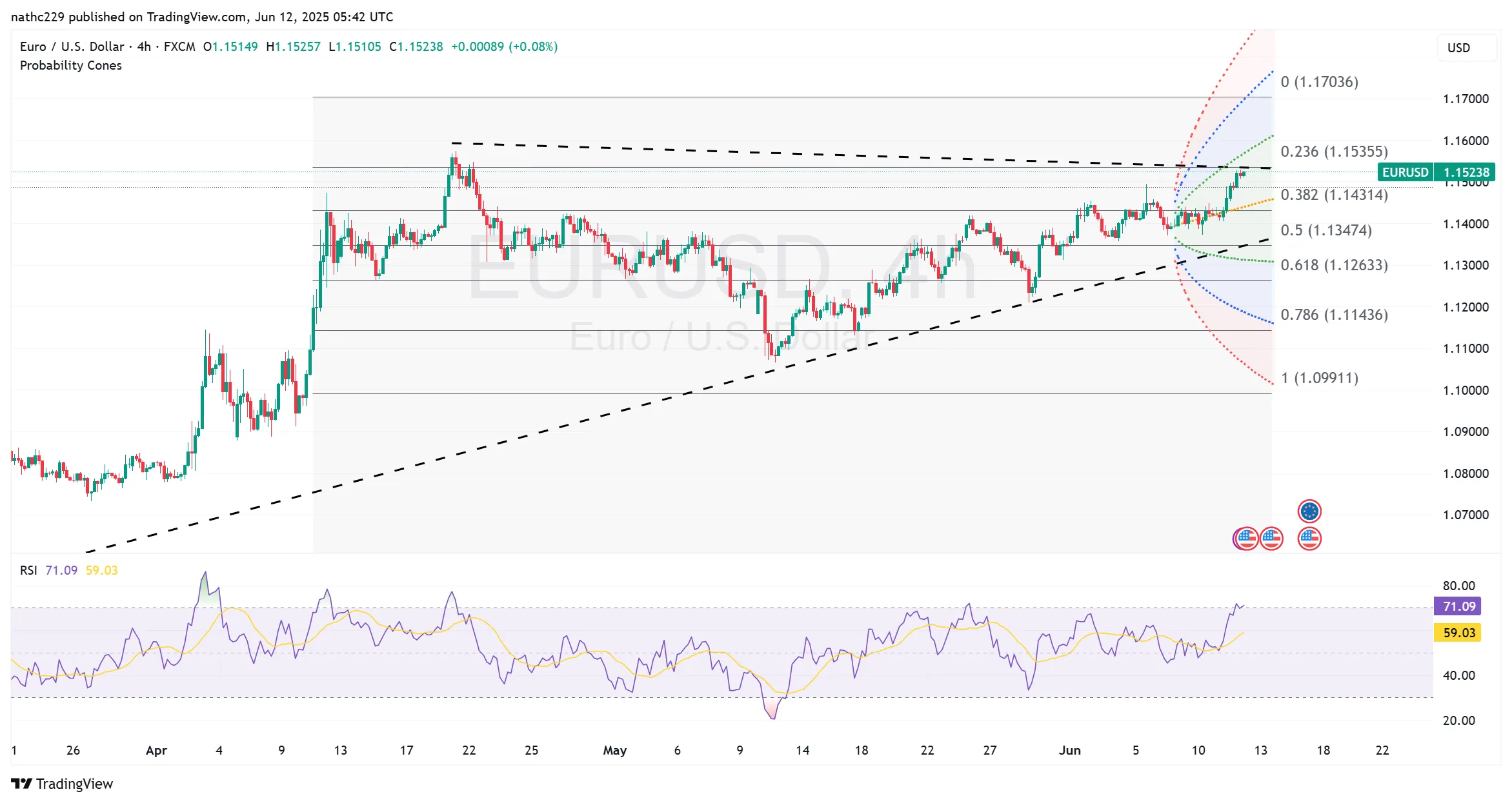
EUR/USD Bulls Energized by Softer U.S. CPI but Face Critical Resistance Ahead
EUR/USD Bulls Energized by Softer U.S. CPI but Face Critical Resistance Ahead
U.S. CPI Release Fuels Euro Rally
EUR/USD surged strongly on Wednesday, climbing to a four-session high of 1.14965, buoyed by weaker-than-expected U.S. Consumer Price Index (CPI) data for May, which suggested inflation pressures may be moderating. The pair opened the New York session near 1.1440 after an overnight low of 1.1406 on EBS, initially dipping but quickly reversing higher as the softer inflation numbers pressured U.S. Treasury yields lower, thereby undermining the U.S. dollar.
The May CPI headline data was notably below market expectations, registering softer month-on-month and year-on-year growth. The benign CPI figures alleviated some concerns that persistent inflation would necessitate continued restrictive monetary policy from the Federal Reserve, thereby reducing the immediate need for higher yields and consequently diminishing the dollar’s attractiveness. This environment allowed EUR/USD to capitalize on short-term dollar weakness, supported by a narrowing of the German-U.S. two-year yield spread.
Interest Rate Expectations Remain Steady
Despite the softer inflation print, the broader interest rate market reaction was surprisingly muted. SOFR futures—an indicator used to gauge market expectations for future Fed policy—barely budged following the data release. Investors continue to anticipate approximately 48 basis points of cumulative Fed rate cuts by the end of 2025, essentially unchanged from pre-release expectations. This cautious response indicates that market participants remain wary and are not yet fully convinced by a single month’s data, implying further evidence may be required before adjusting longer-term views on U.S. interest rate trajectories significantly.
This stability in rate expectations underscores the lingering uncertainty over the Fed’s policy direction amid conflicting signals from inflation, employment, and economic growth indicators. While softer CPI figures could eventually encourage market participants to price in a more aggressive dovish pivot, the absence of immediate shifts suggests a degree of skepticism persists among investors.
Key Economic Indicators in Focus
Moving forward, attention will pivot sharply to upcoming economic releases, particularly those related to employment and consumer sentiment. Thursday’s U.S. weekly jobless claims data will be closely monitored, as rising claims could further reinforce perceptions of weakening labour market conditions. Should claims significantly surpass forecasts, it could trigger further downward pressure on U.S. yields and support additional gains in EUR/USD.
Additionally, traders will pay keen attention to Friday’s preliminary June University of Michigan consumer sentiment index, followed by May’s U.S. retail sales report due next week. Signs of deteriorating consumer confidence or weakening consumer spending will heighten concerns about the robustness of the U.S. economy. If these upcoming data releases reveal further softness, they could serve as the necessary catalysts to shift market expectations more firmly toward a dovish Fed, amplifying downside risks for the U.S. dollar.
Market Factors: Tariff Effects and Economic Outlook
Beyond traditional economic indicators, markets remain attentive to broader geopolitical and trade issues, notably ongoing tariff developments under President Trump’s administration. Market uncertainty related to trade tariffs has consistently influenced U.S. inflation expectations, impacting investment flows and the broader risk sentiment. A sustained moderation in inflation expectations due to tariffs could reinforce market narratives that anticipate a softer Fed policy stance over the medium term, potentially supporting a more sustained EUR/USD rally.
However, it is critical to acknowledge that tariffs carry dual risks: while they might reduce immediate inflation pressures by curbing import-driven price rises, persistent tariffs could simultaneously depress global economic growth, impacting both the U.S. and eurozone negatively. Thus, the overall impact remains ambiguous and continues to introduce heightened volatility into currency markets.
Technical Outlook: Resistance and Risks
From a technical standpoint, EUR/USD bulls currently enjoy supportive indicators. Rising Relative Strength Index (RSI) readings on both daily and weekly charts highlight strengthening bullish momentum. The hold above the 10-day moving average provides immediate support, reflecting bullish sentiment following a May monthly doji pattern, traditionally signaling trend continuation after a period of indecision.
Yet critical resistance near the psychological level of 1.1500 remains a formidable technical barrier. The pair’s repeated challenges at this key resistance area underscore the significance of this level. A decisive break and sustained close above 1.1500 could open up further upside potential, targeting the next major resistance at 1.1625, which aligns with longer-term Fibonacci retracement levels from earlier downtrends.
Conversely, failure to penetrate the 1.1500 level convincingly would signal persistent market caution and potential reversal risks. Initial support remains robust around 1.1400-1.1420 (10-day moving average and recent pivot points), and a break below this zone could prompt a deeper retracement towards the 21-day moving average and rising daily Ichimoku cloud top near 1.1350-1.1370.
In conclusion, EUR/USD’s short-term trajectory hinges significantly on forthcoming economic data, Fed rate expectations, and market sentiment surrounding tariffs and growth concerns. While recent price action suggests bullish tendencies, traders must remain cautious of critical resistance levels and prepare for volatility as key indicators are unveiled.
